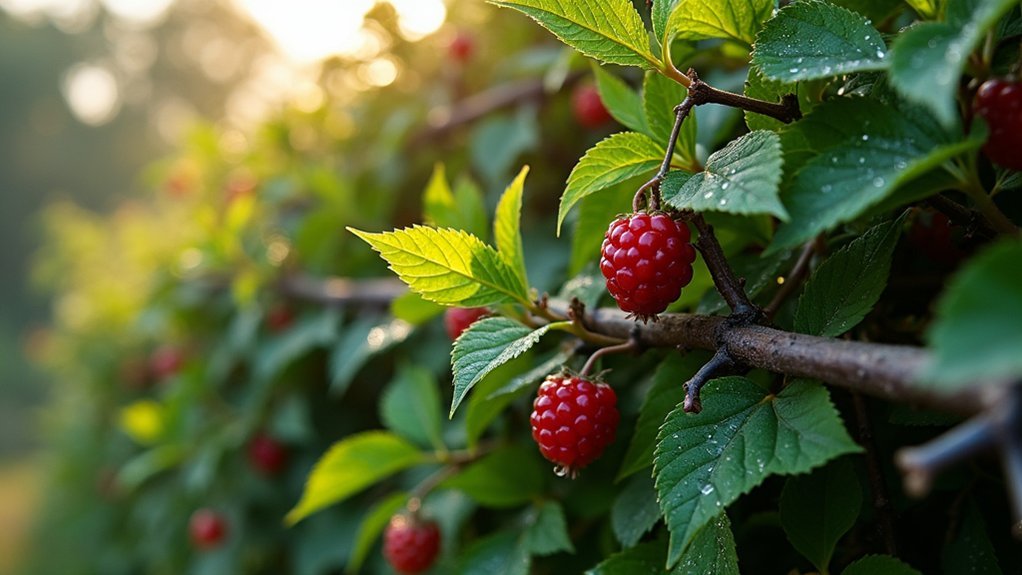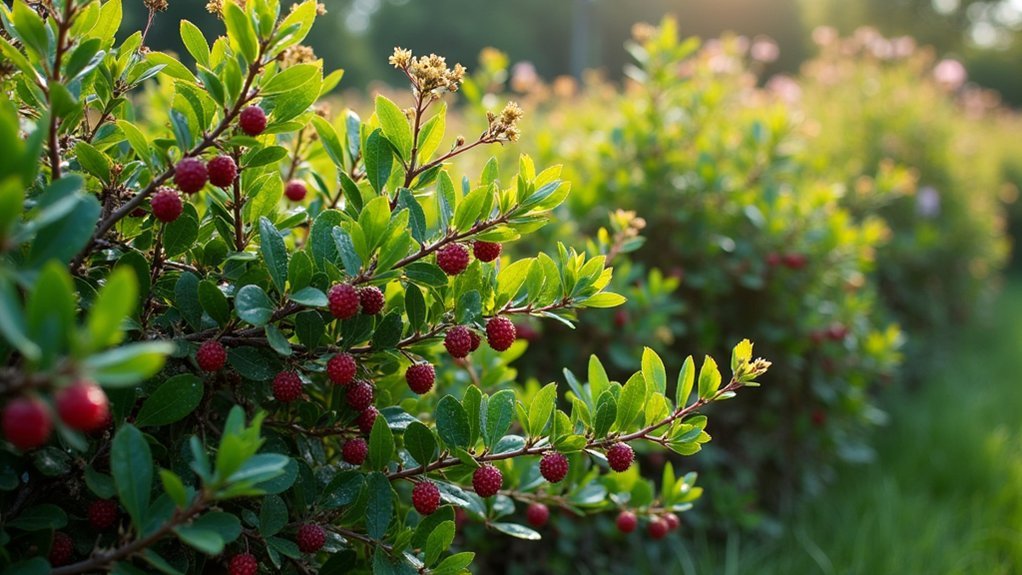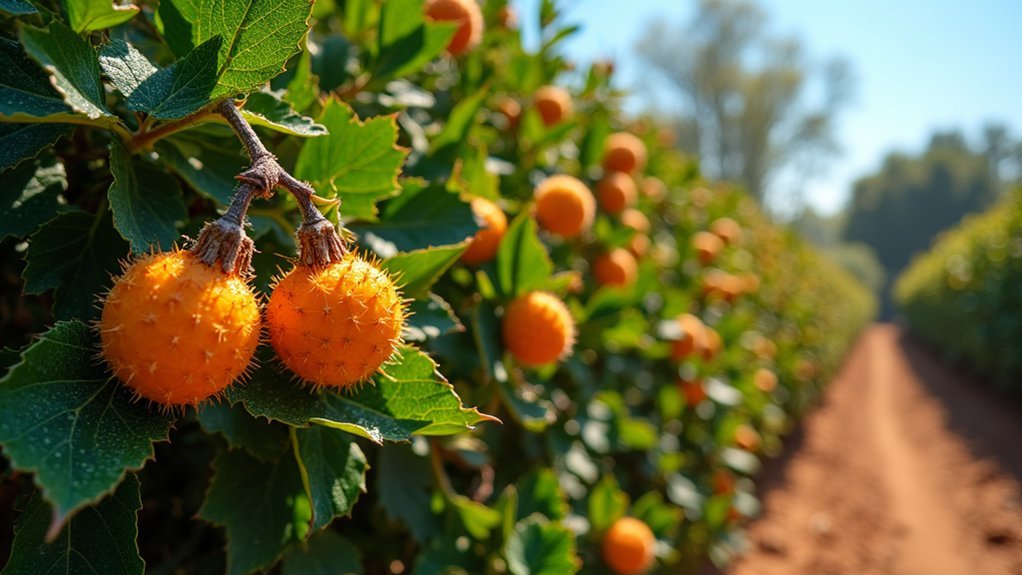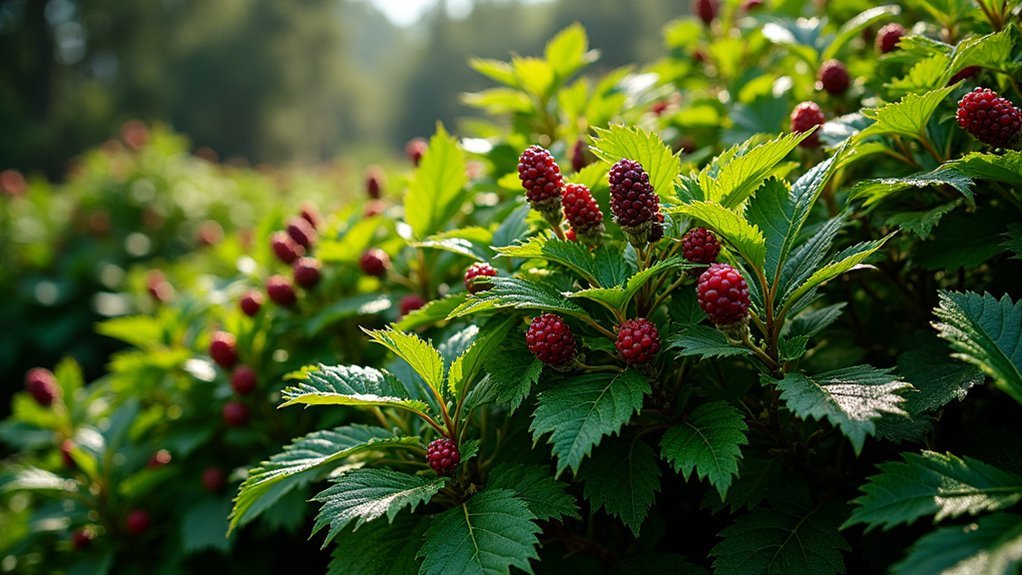Edible security hedges offer natural protection while providing food. Plant thorny varieties like hawthorn, blackberries, and sea buckthorn in layered formations to create impenetrable barriers. You’ll need to balance defensive pruning with fruit production, wearing protective gear during maintenance and harvesting. Choose species that match your climate zone for best results. Strategic “pick zones” every 8-10 feet guarantee safe harvesting without compromising security. The following guide reveals how to transform your property boundary into a delicious defensive asset.
Security Benefits of Edible Thorny Hedges

While traditional security measures like fences and alarm systems have their place, edible thorny hedges offer a natural, multi-functional alternative that combines protection with practicality.
You’ll find these living barriers remarkably effective deterrents, thanks to their dense, impenetrable structure and thorny exterior that discourages even the most determined intruders.
Unlike costly security systems, these hedges provide year-round protection with minimal investment and maintenance once established.
Nature’s sentinels stand guard without monthly fees or complex technology—just soil, sunlight, and seasonal pruning.
Position them strategically around vulnerable entry points for maximum effectiveness.
The beauty lies in their dual purpose: they’ll clearly define your property boundaries while creating an obstacle that’s difficult to climb or penetrate.
For cost-conscious homeowners, this natural security solution proves more economical than building walls or installing electronic systems, while offering permanent protection that becomes more effective as the hedge matures.
Blackberry varieties are particularly excellent choices as they produce sweet fruits while their thorned varieties provide exceptional security benefits.
Top Edible Plants That Double as Security Barriers
After considering the advantages of natural security solutions, let’s explore specific plants that offer both protection and food.
Hawthorn trees provide thorny branches and fall berries perfect for jams, thriving in zones 4-8 with minimal water once established.
Prickly pear cactus deters climbers with its spines while offering edible pads and fruits in zones 9-11.
For varied climates, blackberries form impenetrable thickets in zones 5-9, though they require containment to prevent spreading. Strategic placement near vulnerable corners enhances your overall security design while providing bountiful harvests.
In colder regions (zones 3-7), sea buckthorn tolerates poor soil while producing vitamin-rich berries that require mechanical harvesting.
Goumi berry offers a lower-maintenance option for zones 4-9, with nitrogen-fixing roots that improve soil quality and early summer berries rich in antioxidants.
Design Strategies for Effective Edible Security Hedges

Creating an effective edible security hedge requires thoughtful design that balances defensive capabilities with food production goals. Implement a layered structure with taller species (6-8′) at the back and shorter plants (3-4′) in front, spacing them 18-24″ apart to form an impenetrable barrier while allowing sufficient air circulation. For optimal security results, consider implementing 1-foot spacing with thorny species that will create an even more formidable protective boundary.
| Strategy | Security Benefit | Harvest Advantage |
|---|---|---|
| Layered planting | Creates depth defense | Enables access to different fruits |
| Height gradation | Prevents easy scaling | Improves sunlight distribution |
| Density management | Eliminates gaps | Promotes higher yields |
Train branches outward rather than upward to maximize defensive coverage. Incorporate nitrogen-fixing companions like Siberian pea shrub to improve soil fertility. Remember to create strategic “pick zones” every 8-10′ for safe harvesting without compromising your security perimeter.
Seasonal Care and Maintenance for Prickly Edibles
You’ll need to balance pruning your prickly edible hedge to maintain its defensive structure while encouraging fruit production.
Regular seasonal inspections will help you catch pest issues before they compromise your security barrier’s integrity.
Wear thick protective gloves and clothing when handling thorny varieties, especially during summer when insects might be lurking among the foliage.
For the most effective defensive hedge, consider planting Prunus spinosa (Blackthorn) with its prickly stems that create an impenetrable barrier while providing edible fruits.
Pruning for Production
Mastering the balance between security and harvest requires strategic pruning of your edible defensive hedge. Apply the “3 Ds” method first, removing dead, damaged, and diseased wood to maintain plant health before focusing on production cuts.
| Timing | Approach | Benefit |
|---|---|---|
| Late Winter | Coppice vigorous species | Explosive spring regrowth with formidable thorns |
| Post-Bloom | Thin selective branches | Enhanced sunlight for ripening fruit |
| Early Spring | Angle sides inward | Maintains dense, impenetrable lower growth |
For fruit-bearing species, avoid removing more than 30% of foliage annually to preserve fruiting wood. When rejuvenating older hedges, stagger your renovation over three years, cutting just one-third of old canes annually. This maintains continuous protection while promoting juvenile growth with sharper, more abundant defensive spines and steady fruit production. Thorny varieties like Trifoliate Orange can create formidable barriers while still providing productive harvests when properly managed.
Seasonal Pest Management
While security hedges create physical barriers against unwanted visitors, they face their own invaders throughout the year in the form of pests that can compromise both defense and harvest.
Implementing Integrated Pest Management (IPM) strategies will protect your edible security hedge year-round.
In spring, target emerging aphids and caterpillars with insecticidal soap or neem oil, and install row covers for additional protection.
Summer’s heat brings increased pest pressure—introduce beneficial predators and maintain proper irrigation to reduce plant stress.
As autumn arrives, remove plant debris and manage weeds that harbor pests. Uncontrolled weeds around your security hedges can serve as weed seed banks, creating persistent problems in future growing seasons.
Winter offers a chance to reset—practice thorough sanitation to eliminate overwintering sites and consider cover cropping to support beneficial insects.
Regular monitoring throughout all seasons allows you to detect issues early and respond appropriately before pests gain a foothold.
Climate Considerations When Selecting Security Hedge Plants

Because local climate conditions fundamentally determine your hedge’s survival and effectiveness, selecting climate-appropriate plants is the cornerstone of creating a successful security barrier.
Begin by confirming your USDA hardiness zone and assess microclimate factors like building proximity for wind protection.
In drought-prone regions, choose Mediterranean species like Italian Cypress or Bay, which establish deep root systems that minimize watering needs. Their xeriscaping compatibility helps maintain an effective barrier without constant irrigation.
For frost-prone areas, consider deciduous options like beech that allow winter sunlight while providing summer security. Many thorny security plants like Firethorn and Bougainvillea require specific climate conditions to thrive and provide optimal deterrence.
Don’t forget seasonal leaf retention – evergreens like Thuja plicata guarantee year-round screening, while deciduous varieties accommodate passive solar heating during winter.
Enhance your hedge’s resilience through strategic mulching with pruned clippings to retain soil moisture.
Maximizing Wildlife Benefits While Maintaining Security
A well-designed security hedge doesn’t just protect your property—it creates a thriving ecosystem that benefits local wildlife while maintaining its defensive qualities. By incorporating berry-producing plants like pyracantha and hawthorn, you’ll provide essential food for birds throughout the seasons.
Choose a diverse mix of native, thorny species that create shelter for wildlife while deterring human intruders. These plants form valuable wildlife corridors, allowing animals to move safely between habitats.
Your hedge will become home to beneficial insects that support pollination and natural pest control. When pruning, maintain different heights to create complex habitats while preserving the hedge’s defensive structure. RHS research demonstrates that mixed hedging provides ecosystem services that contribute positively to urban environments.
This approach delivers multiple benefits—security, biodiversity, soil stabilization, and even carbon sequestration—all while creating a living barrier that enhances your property’s ecological value.
Harvesting Techniques for Your Defensive Edible Barrier

Thorny security hedges can yield delicious rewards if you know when and how to harvest their bounty safely. Timing your harvest properly guarantees peak flavor and nutritional benefits while protecting your hands from painful thorns. Incorporating natural defense plants around property boundaries creates both security and culinary benefits.
| Plant | Harvest Time | Usage Tips |
|---|---|---|
| Berberis | Late summer/fall | Pick when fully ripe to reduce bitterness; use in preserves |
| Pyracantha | Autumn | Wash thoroughly; excellent for jellies and syrups |
| Sea Buckthorn | Late autumn | Freeze branches then shake off berries; high in vitamin C |
| Rose Hips | After first frost | Remove seeds before processing; rich in antioxidants |
| Blackthorn | Late autumn | Traditionally used for sloe gin; improves after frost |
Always wear thick gloves when harvesting from thorny plants. For dense barriers like hawthorn and blackthorn, using long-handled pruners can help you reach fruits without injury.
Frequently Asked Questions
How Long Before Thorny Edible Hedges Reach Full Security Effectiveness?
You’ll see your thorny edible hedges reach full security effectiveness in 3-5 years, with initial deterrence developing by year 2 as thorns mature and plants grow dense enough to form an impenetrable barrier.
Can These Hedges Deter Larger Animals Like Deer and Bears?
Thorny hedges will deter deer effectively, as they’re sensitive to both thorns and strong scents. You’ll find they’re less reliable against bears, which can tolerate thorns better. Consider combining with other deterrents for maximum effectiveness.
Are There Liability Concerns if Trespassers Injure Themselves on Thorny Hedges?
Yes, you face liability concerns if trespassers injure themselves on your thorny hedges. You’re responsible for maintaining reasonable safety and may need to post warning signs about potential hazards on your property.
How Do Thorny Hedges Affect Property Value and Insurance Premiums?
Thorny hedges can increase your property value up to 20% by improving curb appeal and security. They won’t directly affect insurance premiums, but your well-maintained landscaping generally contributes to lower overall insurance costs.
Can Thorny Security Hedges Be Incorporated Into Permaculture Designs?
Yes, you can seamlessly integrate thorny security hedges into permaculture designs. They’ll provide multiple functions—creating wildlife habitat, serving as windbreaks, establishing boundaries, and potentially offering edible yields—all while embodying core permaculture principles.
In Summary
You’ve now got all the tools to create a hedge that protects your property and feeds your family. Remember, your thorny barrier isn’t just a deterrent to intruders—it’s a productive part of your landscape. With proper planning and maintenance, you’ll enjoy both security and seasonal harvests for years to come. Don’t wait to transform your property boundaries into these multifunctional living fences.





Leave a Reply